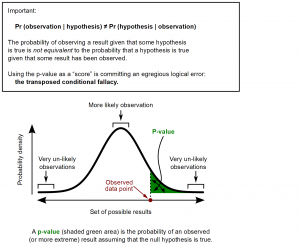Many Statistics students may wonder how the methods and tests learned in class can be applied outside of class. Especially, some test statistics and p-values that confuse students seem boring and meaningless, yet their applications are rarely mentioned in most of elementary statistics courses.

Example of Statistical Test
Credit: WikiPedia
An article published recently described an experiment to turn introductory statistics students into consultants. Adam F. Childers, James Madison University found that guiding students to analyze real data from Facebook helps them learn how to use statistical methods and provide useful suggestions for local businesses and organizations. The project promotes students’ interest in different statistics methods and enhances their understanding of statistics and its value further.
Motivate Students’ Interest
The author built up a semester-long project in his introductory statistics course, which provided an opportunity for students to learn descriptive and inferential statistics by applying it to real-world Facebook data. Students were split up into different groups to cooperate with local organizations. During the project, students had the chance to understand how their organization uses Facebook, which they could use for data analysis. Thanks to the project, students were put in an active position to help companies make better decisions. It was a good motivation for students to learn to apply statistics methods, which is exactly what the whole project was mainly dependent on.

Are statistics boring?
Credit: WordPress
Better to Understand Statistics
Also, students were asked to write a report about previous findings, which was a crucial part of the project according to Adam’s article. It was aimed to enable students to understand statistics. I agree with Adam for the same reason that students need to understand and apply others’ researches in case that they encounter any potential problem in the project.
Comprehend Statistics’ Real-Life Value
Finally, students needed to show their research results to their partner organizations. It was the most exciting part of the project. If I had the chance to participate in the project, I would have been proud of presenting my findings, obtained by statistics methods based on the data acquired from Facebook, to my partner organization. I could have known how useful my suggestions were to the organization—which is meaningful because all work done in the project would help the organization to grow better in the real world rather than merely concluding a rejection of null hypothesis on paper.

Credit:YouTuBe
No matter the suggestions worked or not, the participating students all took their first steps to become consultants. In my opinion, the most important thing for consulting is not just doing theoretical analysis on paper and make a decent conclusion but instead, applying your findings in the real world and validating the results. There are many unmeasurable variables varying from time to time in the real world that are missing on paper. Thus, there is no better way to learn better than doing a real-world application. Not only introductory students, graduate students also need to pay attention to this problem, because after all, statistics is a powerful tool to solve issues in real life.
Hao Huang


